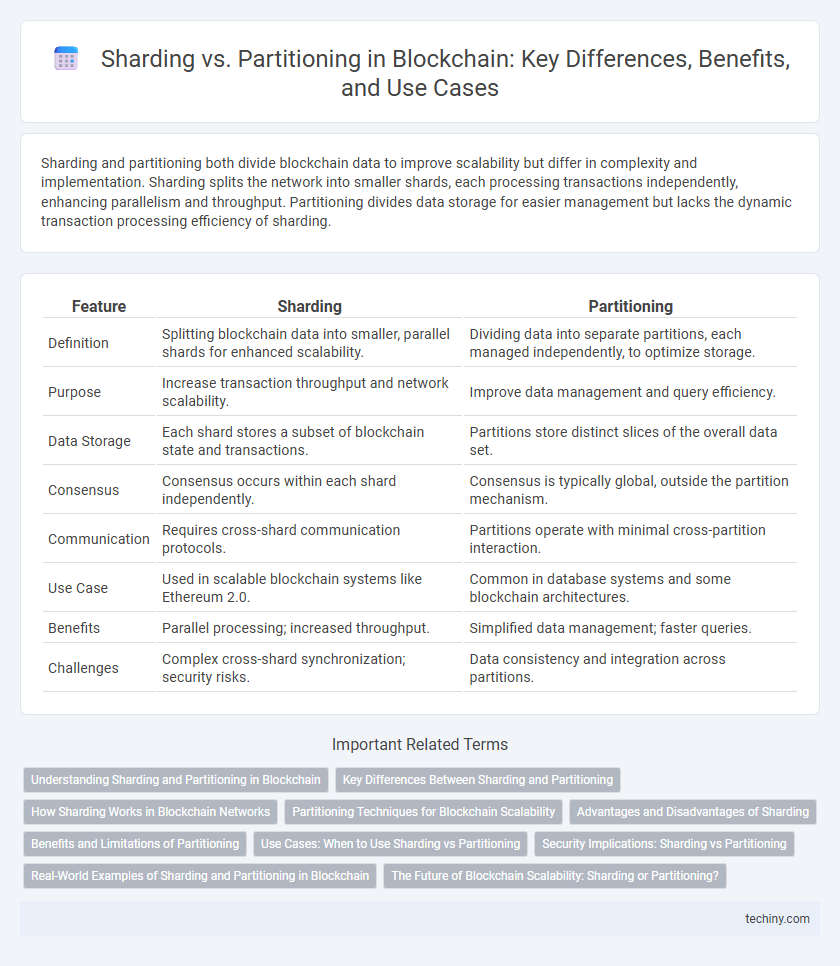Sharding and partitioning both divide blockchain data to improve scalability but differ in complexity and implementation. Sharding splits the network into smaller shards, each processing transactions independently, enhancing parallelism and throughput. Partitioning divides data storage for easier management but lacks the dynamic transaction processing efficiency of sharding.
Table of Comparison
| Feature | Sharding | Partitioning |
|---|---|---|
| Definition | Splitting blockchain data into smaller, parallel shards for enhanced scalability. | Dividing data into separate partitions, each managed independently, to optimize storage. |
| Purpose | Increase transaction throughput and network scalability. | Improve data management and query efficiency. |
| Data Storage | Each shard stores a subset of blockchain state and transactions. | Partitions store distinct slices of the overall data set. |
| Consensus | Consensus occurs within each shard independently. | Consensus is typically global, outside the partition mechanism. |
| Communication | Requires cross-shard communication protocols. | Partitions operate with minimal cross-partition interaction. |
| Use Case | Used in scalable blockchain systems like Ethereum 2.0. | Common in database systems and some blockchain architectures. |
| Benefits | Parallel processing; increased throughput. | Simplified data management; faster queries. |
| Challenges | Complex cross-shard synchronization; security risks. | Data consistency and integration across partitions. |
Understanding Sharding and Partitioning in Blockchain
Sharding in blockchain involves splitting the entire network into smaller, manageable segments called shards, each capable of processing transactions independently to enhance scalability and throughput. Partitioning refers to dividing data or workload into distinct sections to optimize storage and query efficiency but may not inherently increase transaction processing speed like sharding. Understanding the difference clarifies that sharding directly improves transaction capacity by parallel processing, whereas partitioning primarily improves data management within the blockchain infrastructure.
Key Differences Between Sharding and Partitioning
Sharding divides a blockchain network into smaller, independent shards that process transactions in parallel, enhancing scalability by enabling concurrent operations on different subsets of data. Partitioning splits a database or ledger into distinct segments based on data attributes but does not inherently support parallel transaction processing across the partitions. Unlike partitioning, sharding achieves higher throughput and efficiency by distributing both data storage and transaction execution, which is critical for blockchain environments aiming to scale without compromising security or decentralization.
How Sharding Works in Blockchain Networks
Sharding in blockchain networks involves splitting the entire network into smaller, manageable segments called shards, each processing its own transactions and smart contracts independently. This technique increases scalability by enabling parallel transaction processing, reducing latency, and enhancing throughput without compromising security or decentralization. Validators within each shard handle consensus locally, allowing the network to process multiple blocks simultaneously while ensuring data availability and cross-shard communication through specialized protocols.
Partitioning Techniques for Blockchain Scalability
Partitioning techniques in blockchain scalability involve dividing the blockchain database into smaller, manageable segments called shards or partitions to enhance transaction throughput and reduce latency. Effective partitioning reduces node storage and computational requirements by enabling parallel processing of transactions across different partitions while maintaining consensus and security. Common methods include state partitioning, where the ledger state is split among shards, and transaction partitioning, which assigns different transactions to separate partitions for concurrent execution.
Advantages and Disadvantages of Sharding
Sharding in blockchain enhances scalability by dividing the network into smaller, manageable segments called shards, enabling parallel transaction processing and reducing latency. However, sharding introduces complexities in maintaining security and data consistency across shards, increasing the risk of cross-shard communication delays and potential vulnerabilities like shard takeovers. While sharding significantly improves throughput compared to traditional partitioning, it demands sophisticated consensus mechanisms and coordination to prevent fragmentation and ensure network integrity.
Benefits and Limitations of Partitioning
Partitioning in blockchain enhances scalability by dividing data into manageable segments, enabling parallel processing and reducing network congestion. It simplifies data access and improves query performance but may introduce complexities in maintaining data consistency and security across partitions. Partitioning's effectiveness depends on the blockchain's design, balancing between increased efficiency and the risk of data isolation or fragmentation.
Use Cases: When to Use Sharding vs Partitioning
Sharding optimizes blockchain scalability by dividing the ledger into smaller, manageable pieces called shards, ideal for decentralized applications requiring high throughput and parallel processing, such as large-scale public blockchains like Ethereum 2.0. Partitioning suits permissioned or private blockchains needing data segmentation for improved access control and localized transaction processing, often used in enterprise solutions for supply chain management or financial services. Choosing sharding enhances network performance in fully decentralized environments, while partitioning prioritizes data privacy and compliance within restricted-access systems.
Security Implications: Sharding vs Partitioning
Sharding divides a blockchain network into smaller, independent shards, each processing transactions in parallel, enhancing scalability but increasing vulnerability to cross-shard attacks and data inconsistency. Partitioning isolates segments of the blockchain for improved performance and data management, yet can reduce overall network security by creating silos that attackers might exploit to compromise isolated partitions. Security implications of sharding involve risks like shard takeover attacks and cross-shard communication complexity, whereas partitioning risks include reduced fault tolerance and potential data fragmentation impacting consensus robustness.
Real-World Examples of Sharding and Partitioning in Blockchain
Sharding in blockchain is exemplified by Ethereum 2.0, which divides the network into multiple shards to enable parallel transaction processing and increase scalability. Partitioning appears in projects like Apache Cassandra integrated with blockchain frameworks, where data is segmented across nodes to optimize storage and access. Both methods enhance system performance but target different layers of blockchain architecture; sharding improves consensus efficiency while partitioning manages data distribution.
The Future of Blockchain Scalability: Sharding or Partitioning?
Sharding and partitioning offer distinct approaches to blockchain scalability, with sharding dividing the network into smaller, manageable pieces called shards, each processing transactions in parallel to increase throughput. Partitioning organizes data across multiple nodes to optimize storage and query execution but can face limitations in cross-partition communication. The future of blockchain scalability hinges on integrating sharding's parallelism with advanced partitioning techniques to achieve high transaction capacity while maintaining decentralization and security.
Sharding vs Partitioning Infographic

 techiny.com
techiny.com